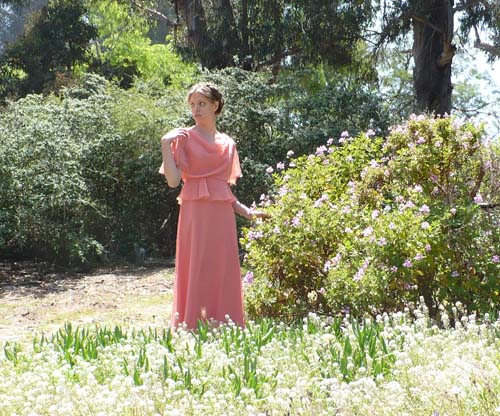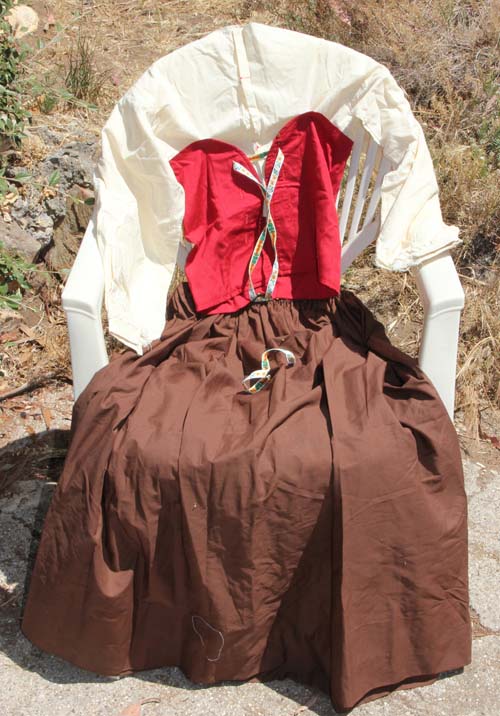Aprons, Part 7
May 23rd, 2012
I’m running out of things to say about aprons.
Today’s pairing features stylized flowers — they scream 1950s to me, but they could also be from the 1970s, when 1950s style saw a resurgence (think Happy Days, Grease).
Number one is pretty basic, relying on the printed fabric for decorative effect.

And a more elaborate apron of geometric daisies with red trim and patch pockets.

Hallowe’en, Age 12
May 22nd, 2012
I was really into Greek and Roman mythology (thanks to home schooling, the last bastion of the classics) as a child. I think I’d just graduated from the D’Aulaires to Bulfinch when I decided to costume myself as Aphrodite for Hallowe’en.
The dress was a thrift store find. Probably donated by some bemused bridesmaid who didn’t look well in peach, or who anticipated relatively few toga* party invitations. It’s actually a rather lovely dress if you don’t mind polyester chiffon. And it certainly fits better now than it did then. I recall some fast work with safety pins around the shoulders.

(Pardon the idyllic setting, it’s just our front yard — what a difference from Thompson & Bleecker, Greenwich Village!)
The real effect of the costume was made not by the dress however, but by the embellishments we added. They’re long disbanded, alas. So you’ll have to use your imagination.
- Naturally I had a crown of flowers.
- Some say Aphrodite carried the seasons on her feet (I’ve heard of stranger things), so my mother decked out a pair of sneakers with fall leaves, spring flowers, winter snow, and summer fruit.
- And of course you’ll recall that Aphrodite bore a son, Eros, god of love, aka Cupid. Which inspired my ingenious μήτηρ to kit out my otherwise nude “Fun In The Sun” Cabbage Patch doll with a bow and quiver of heart-tipped arrows.
Of all my old costumes, this is the one I see myself continuing to wear. Minus the naked Cabbage Patch Doll of course.
*Yes, I realize this is a chiton, but how many chiton parties have you seen? Hmmm. Interesting idea actually…
Sonatina
May 21st, 2012
I love musical terminology. It’s all so, well musical. Or perhaps Italian is simply a lyrical language. Which leads one to wonder how they happened to choose Italian for musical notation. But that’s another story altogether.
I’ve been re-learning Clementi’s Sonatinas lately and, while trying to master a particularly thorny bit of fingering, began to wonder whether the sonatina form had any particular characteristics. Turns out, sonatina simply means a little sonata. (Sonata being a piece of music that is played, not sung, derived from the Latin sonare, “to sound” — thank you Wikipedia).
Unlike a sonnet (I’ve been reading Edna St. Vincent Millay), or even a sonata, the sonatina has no formal requirements of form. It’s just a collection of movements, unspecified in number, character, or arrangement, and is too short or too simple to make a fully formed sonata.

Muzio Clementi (1752-1832) was a prolific Italian composer and noted pedagogue. He wrote a series of sonatinas for his piano students in 1797 and I am testament to the fact that they were still in use 200 years later when I was winding up my own stint as a piano student. You can learn more about the “father of the pianoforte” from the Clementi Society.
I can’t resist sharing the following excerpt from the introduction to my “Schirmer’s Library” edition of Clementi’s Sonatinas. It was written by Philip Hale in 1893 and is a good argument for writing your own biographical blurb now if you intend to be posthumously published.
“The career of Clementi was remarkably free from the adventures, the disappointments, the reverses, that are so often connected with the artistic life. It was so free from romance that the biographers of the last century felt obliged to invent incidents of passion. He was a favorite in society, for his manners were elegant, and he was always a cheerful and entertaining companion. He enjoyed a game of billiards, but he was frugal in his habits. He was exceedingly fond of money, and many amusing stories are told of his stinginess. He was industrious, and often gave fifteen hour-lessons a day at a guinea a lesson. It is unnecessary to add that by teaching, playing, composing, improvements in the pianoforte, and a diligent pursuit of business, he was able to leave a large fortune.”
Oh my.
Aprons, Part 6
May 20th, 2012
Yes, they are endless. But at least you only have to read about them. I, on the hand…
The aprons featured in this post are both sheer. The first is one of my favorites, of blue dotted Swiss. I have a thing for dotted Swiss. The red rick rack doesn’t hurt either. And check out the shaped waistband and scalloped hem. I’m taking a guess that this one is from the 1950s.
The next one is badly faded, but there are faint remnants of stenciled flowers on the pocket and along the hem.

It’s got me stumped as far as age though. Could be as early as the 1940s based on the delicate fabric and fine sewing. What do you think?
Hallowe’en, Age 11
May 19th, 2012
Finally, we come to a costume that’s just too darn small for me to get on anymore.

If you can’t tell by looking, I was a milkmaid. The brown skirt was ankle length (it’s the only part that still fits at all — now it falls about mid-calf). The white peasant blouse closes in the front with velcro and the red bodice fastens over it with more velcro. No wardrobe malfunctions here. There are matching pieces of the flowered lacing ribbon for my braids. I like to think I carried a milk pail instead of candy bag that year…
This costume also makes me a liar. I wrote before that 14 was the first year I made my entire costume. Well that’s just not true. Despite maternal help with costumes 12 and 13 (those posts are on their way), I sewed this one on my own too.
Interesting that my obsession with romanticized female farm laborers of the 18th and 19th centuries began at such an early age. Had I just learned that the stereotypical beauty of milkmaids was largely due to their exposure to cowpox (with resulting immunity to the disfiguring scourge of post-Renaissance Europe, smallpox)? Or was I (am I) simply echoing a genetic imperative from my Germanic and Celtic forebears?
« Newer Posts — Older Posts »
